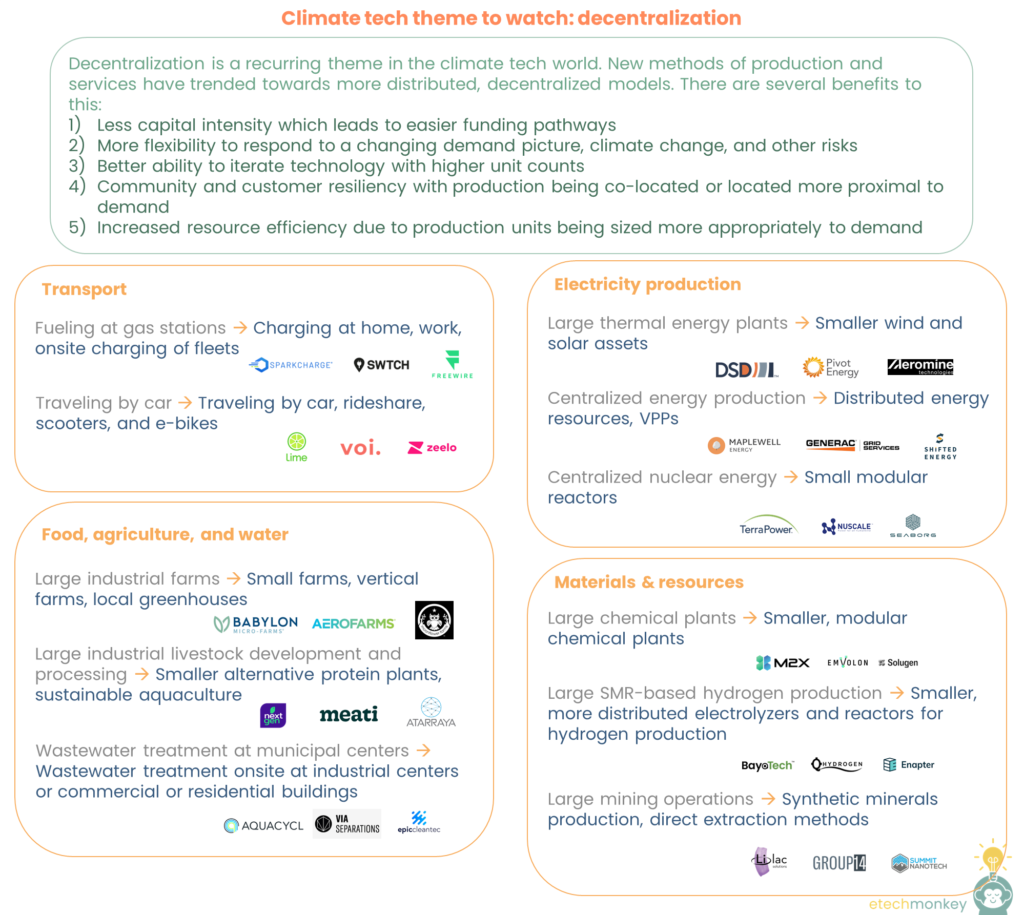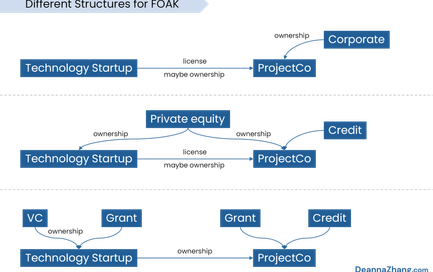

I’ve been looking how we might be able to create a financial ecosystem tailored to growing and scaling climate tech and what themes might impact that kind of financial ecosystem. One of these themes is this concept of decentralization.
Many different climate tech sectors rely on decentralized models of producing goods and services, following a broader industrial trend of localizing manufacturing and reshoring industrial facilities. While this goes against the traditional paradigm of centralizing everything to achieve optimal economies of scale, there are clear benefits to following a decentralized model:
- Less capital intensity - one of the biggest advantages of decentralized models is that they require less capital to get started. Traditionally, large, centralized production facilities have required huge amounts of investment to set up, which can be a barrier for many entrepreneurs and startups. Decentralization, on the other hand, enables smaller-scale, distributed production, which can be achieved with lower capital investments. This leads to easier funding pathways, as it allows for more entrepreneurs to enter the market and compete.
- More flexibility - decentralized models also offer more flexibility to respond to a changing demand picture, climate change, and other risks. Large, centralized facilities can be difficult to adapt and retool quickly, whereas smaller, more distributed production units can be more nimble and responsive to changes in demand or new environmental threats. This can lead to a more efficient use of resources and less waste.
- Better ability to iterate technology - decentralized models also have a better ability to iterate technology with higher unit counts. Smaller-scale production units can be designed and built more quickly, enabling more iterations to be tested in a shorter amount of time. This can lead to faster innovation and more efficient technology development, which can ultimately help address the climate crisis more effectively.
- Community and customer resiliency - decentralization also enables community and customer resiliency, as production is co-located or located more proximal to demand. This can help mitigate the risks associated with supply chain disruptions or natural disasters, which can have a significant impact on traditional centralized production facilities. By spreading production across a wider geographic area, decentralized models can help ensure that essential goods and services are available to local communities even in the event of a disruption.
- Increased resource efficiency - decentralized models can lead to increased resource efficiency due to production units being sized more appropriately to demand. Traditional centralized facilities often produce goods in large quantities, which can lead to waste if demand is not met. Decentralization enables smaller, more appropriately sized production units, which can help reduce waste and improve overall efficiency.
On specifically the finance front, decentralization can be an alleviating trend to climate tech’s FOAK problems. As more project sponsors and offtakers buy into building infrastructure for new decentralized paradigms vs. building infrastructure for old centralized paradigms, we may be able to use the VC growth model to scale up more of climate tech.
In the past, my posts have focused on how finance can adapt to scale up climate tech and how scaling climate tech is a uniquely challenging problem…but diving into themes like this is a good reminder that 1) the problem is evolving and 2) that the “compromise” doesn’t necessarily have to be completely from the finance side…perhaps technology can evolve to be more fitting to our financial ecosystem.
I see 11 areas in climate tech clearly embodying the decentralization theme (though I’m sure there are more!):
- Fueling at gas stations ⟶ Charging at home, work, onsite charging of fleets
- Example companies: SparkCharge, Swtch, Freewire
- Traveling by car ⟶ Traveling by car, rideshare, scooters, and e-bikes
- Large industrial farms ⟶ Small farms, vertical farms, local greenhouses
- Example companies: Babylon, Aerofarms, Moonflower Farms
- Large industrial livestock development and processing ⟶ Smaller alternative protein plants, sustainable aquaculture
- Wastewater treatment at municipal centers ⟶ Wastewater treatment onsite at industrial centers or commercial or residential buildings
- Example companies: Aquacycl, Via Separations, Epic Cleantec
- Large thermal energy plants ⟶ Smaller wind and solar assets
- Example companies: DSD Renewables, Pivot Energy, Aeromine
- Centralized energy production ⟶ Distributed energy resources, VPPs
- Example companies: Maplewell Energy, Generac Grid Services, Shifted Energy
- Centralized nuclear energy ⟶ Small modular reactors
- Example companies: TerraPower, NuScale, Seaborg
- Large chemical plants ⟶ Smaller, modular chemical plants
- Example companies: M2X Energy, Emvolon, Solugen
- Large SMR-based hydrogen production ⟶ Smaller, more distributed electrolyzers and reactors for hydrogen production
- Example companies: Bayotech, Q Hydrogen, Enapter
- Large mining operations ⟶ Synthetic minerals production, direct extraction methods
- Example companies: Lilac Solutions, Group14, Summit Nanotech



CERAWeek Reflections, FOAK Happy Hour Diagrams, and New Blog (no more Etechmonkey!)


